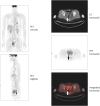Diagnostic value of integrated ¹⁸F-fluoro-2-deoxyglucose positron emission tomography/computed tomography in recurrent epithelial ovarian cancer: accuracy of patient selection for secondary cytoreduction in 134 patients
- PMID: 29400023
- PMCID: PMC5920220
- DOI: 10.3802/jgo.2018.29.e36
Diagnostic value of integrated ¹⁸F-fluoro-2-deoxyglucose positron emission tomography/computed tomography in recurrent epithelial ovarian cancer: accuracy of patient selection for secondary cytoreduction in 134 patients
Abstract
Objective: The aim of this study was to evaluate the diagnostic value of integrated ¹⁸F-fluoro-2-deoxyglucose-positron emission tomography/computed tomography (¹⁸F-FDG-PET/CT) for suspected recurrence of epithelial ovarian cancer (EOC) with non-disseminated lesions.
Methods: We retrospectively reviewed the medical records of recurrent EOC patients who underwent secondary cytoreduction from January 2000 to December 2013. A total of 134 patients underwent secondary cytoreduction after imaging with either ¹⁸F-FDG-PET/CT or contrast-enhanced computed tomography (CECT).
Results: In a patient-based analysis of 134 patients, 124 (92.5%) were confirmed to be positive for malignancy. Among 72 patients with suspected non-disseminated recurrence on ¹⁸F-FDG-PET/CT, 65 (89.0%) were confirmed to have recurrence, giving 98.5% sensitivity, 87.7% accuracy, and 88.9% positive predictive value (PPV). In the 65 patients with recurrence, residual tumor remained in 14 patients, giving an accuracy of patient selection for secondary cytoreduction of 69.4% (50/72) and it is higher than that of CECT (64.0%). In 169 lesions removed from patients who underwent preoperative ¹⁸F-FDG-PET/CT, 135 (79.9%) were confirmed to be positive for malignancy and 124 were accurately detected by ¹⁸F-FDG-PET/CT, giving 91.9% sensitivity, 81.1% accuracy, and 85.5% PPV. Foreign body granuloma was found in 33.3% of 21 lesions with false-positive ¹⁸F-FDG-PET/CT findings (7/21). The mean preoperative cancer antigen 125 (CA-125) level in false-positive patients was 28.8 U/mL.
Conclusion: Compared with CECT, ¹⁸F-FDG-PET/CT shows higher sensitivity in lesion-based analysis and better accuracy of patient selection for secondary cytoreduction. However, there is still a need for integration of the results of ¹⁸F-FDG-PET/CT, CECT, and CA-125 levels to aid treatment planning.
Keywords: Cytoreduction Surgical Procedures; Granuloma, Foreign-Body; Ovarian Neoplasms; Positron Emission Tomography Computed Tomography.
Copyright © 2018. Asian Society of Gynecologic Oncology, Korean Society of Gynecologic Oncology.
Conflict of interest statement
No potential conflicts of interest relevant to this article was reported.
Figures

Similar articles
-
The role of F18-FDG PET/CT in predicting secondary optimal de-bulking in patients with recurrent ovarian cancer.Surg Oncol. 2017 Dec;26(4):347-351. doi: 10.1016/j.suronc.2017.07.004. Epub 2017 Jul 13. Surg Oncol. 2017. PMID: 29113651
-
18F-FDG PET/CT in ovarian cancer recurrence: Clinical impact, correlation with ceCT and CA-125, and prognostic value.Rev Esp Med Nucl Imagen Mol (Engl Ed). 2021 Jul-Aug;40(4):207-213. doi: 10.1016/j.remnie.2020.09.011. Epub 2020 Dec 2. Rev Esp Med Nucl Imagen Mol (Engl Ed). 2021. PMID: 34218882
-
Use of (18)F-FDG PET/CT in the preoperative evaluation of patients diagnosed with peritoneal carcinomatosis of ovarian origin, candidates to cytoreduction and hipec. A pending issue.Eur J Radiol. 2016 Oct;85(10):1824-1828. doi: 10.1016/j.ejrad.2016.08.006. Epub 2016 Aug 11. Eur J Radiol. 2016. PMID: 27666623
-
[F-18-FDG positron emission tomography in the diagnosis of ovarian recurrence. Comparison with CT scan and CA 125].Rev Esp Med Nucl. 2003 Jul-Aug;22(4):217-23. doi: 10.1016/s0212-6982(03)72189-2. Rev Esp Med Nucl. 2003. PMID: 12846945 Review. Spanish.
-
Impact of FDG-PET and -PET/CT imaging in the clinical decision-making of ovarian carcinoma: an evidence-based approach.Womens Health (Lond). 2012 Mar;8(2):191-203. doi: 10.2217/whe.11.91. Womens Health (Lond). 2012. PMID: 22375721 Review.
Cited by
-
Current update on malignant epithelial ovarian tumors.Abdom Radiol (NY). 2021 Jun;46(6):2264-2280. doi: 10.1007/s00261-021-03081-0. Epub 2021 Jun 5. Abdom Radiol (NY). 2021. PMID: 34089360 Review.
-
18F-FDG PET/MRI and 18F-FDG PET/CT for the Management of Gynecological Malignancies: A Comprehensive Review of the Literature.J Imaging. 2023 Oct 13;9(10):223. doi: 10.3390/jimaging9100223. J Imaging. 2023. PMID: 37888330 Free PMC article. Review.
-
Meta-analysis of the diagnostic value of 18F-FDG PET/CT in the recurrence of epithelial ovarian cancer.Front Oncol. 2022 Nov 7;12:1003465. doi: 10.3389/fonc.2022.1003465. eCollection 2022. Front Oncol. 2022. PMID: 36419900 Free PMC article.
References
-
- Siegel R, Naishadham D, Jemal A. Cancer statistics, 2013. CA Cancer J Clin. 2013;63:11–30. - PubMed
-
- Thrall MM, DeLoia JA, Gallion H, Avril N. Clinical use of combined positron emission tomography and computed tomography (FDG-PET/CT) in recurrent ovarian cancer. Gynecol Oncol. 2007;105:17–22. - PubMed
-
- Niloff JM, Knapp RC, Lavin PT, Malkasian GD, Berek JS, Mortel R, et al. The CA 125 assay as a predictor of clinical recurrence in epithelial ovarian cancer. Am J Obstet Gynecol. 1986;155:56–60. - PubMed
-
- Högberg T, Kågedal B. Long-term follow-up of ovarian cancer with monthly determinations of serum CA 125. Gynecol Oncol. 1992;46:191–198. - PubMed
MeSH terms
Substances
LinkOut - more resources
Full Text Sources
Other Literature Sources
Medical
Research Materials
Miscellaneous

